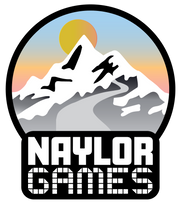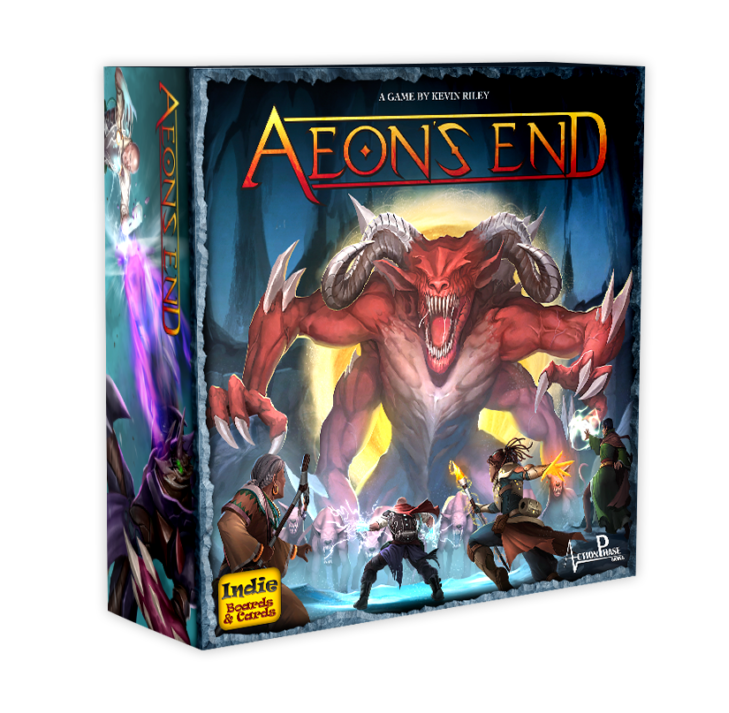This week, Jaya writes a functional review co-operative ‘boss fight’ deckbuilder Aeon’s end, exploring the subtle ways it plays with deckbuilding conventions to deliver on its thematic premise.
Player activity summary
Aeon’s end is best summarised as a video game ‘boss fight’ in cardboard form. Players work together as a group of desperate ‘breach mages’ trying to protect their own from a variety of horrifying nemeses; using new and unfamiliar magic that appeared alongside these monsters to defeat them. Players will buy new cards and skills to improve their deck, invest in opening their ‘breaches’ (the conduits they require in order to cast multiple spells at a time) and keep an eye on the health totals, not just for each individual player but also the city they are defending. Players win when the monster is defeated.
We will win this war not with swords, but with decks of cards.
In many ways, Aeon’s End is does what we expect from deckbuilders: using hands of five cards to make resources, buy better cards from a series of shop stacks and then use the more powerful cards to drive the game outcome: in this case to defeat the boss. But in the context of this game’s narrative and theme, the natural power arcs of deck-building are a stronger mechanical fit than usual.
In the game’s world, players are users of a new kind of magic that they’re unfamiliar with. They’re learning the ways of magic on the fly, just as we are learning how to shape our deck to meet the challenge. Their starting hands, like the classic deckbuilder are palpably weak. The basic ‘spark’ spells inflict a paltry one damage against a nemesis with 70 life supported by minions with at least five. The impossibly underpowered starting cards make them feel as powerless as the characters themselves are to defeat this looming nemesis. But as the game goes on – as the characters’ knowledge of magic grows – so the player’s decks grow more powerful; until the point that combinations of cards and abilities deal upward of 30 satisfying damage in a single turn.
While such a power arc is a strong thematic embodiment of classic deckbuilding patterns, it deviates substantially in other ways from the classic form. In Aeon’s End players never shuffle their deck; instead merely flipping their discard piles face down and drawing from them. Unlike the conventional deckbuilder, this gives players far greater control over their upcoming draws because they have total control over the order they discard cards after use. Planning turns far in advance suddenly becomes possible; opening up all sorts of new avenues of decision-making.
Aeon’s End also gifts players the ability to retain cards in their hand between rounds should they choose to do so, sidestepping one of the biggest disappointments of the deckbuilding experience: the inevitable ‘feelsbad’ when the elements needed to to pull off a satisfying combo consistently emerge in different hands or the trashing card keeps being drawn to greet an empty discard pile. Instead, Aeon’s End provides the comfort to players that they will always be able to pull off a ‘big turn’ if they’re willing to hold onto something for a round or two.
Inevitably this adds complexity, but the reward is worth it because the effect itself is not too unbalancing. Most players I’ve observed engage enough to feel like they’re achieving something using the ability, but never so much it paralyzes their thought process as they seek to devise the perfect order. Indeed, even if players choose not to order their cards, they can still perform well. It’s a satisfying lever players can pull that can nudge them in a small way to victory but it doesn’t overly punish those that would prefer not to engage with the complex forecasting it enables.
The asymmetry of starter player decks further takes this game away from what we have become accustomed to. At the beginning of the game each player will pick a character that has a different composition of sparks (basic attacks) vs crystals (basic economy cards) in their deck. Each character also has a unique signature card exclusive to them and different numbers of open ‘breaches’ the game’s system for managing how many spells can be played.
The asymmetrical effects are a relatively small gesture towards genuine power differences in the grand scheme of the game; the choice of common cards purchased is much more impactful. But it’s enough to make each player feel like they are making a unique contribution to the grand battle. Perhaps most importantly of all, it fosters a true spirit of co-operation: where I am weak I know I can rely on someone else to be strong.
It just keeps getting bigger
It has to be said that the daunting challenge is not an uncommon trope for beginning of a co-op game. The fire in the house in Flashpoint (especially in its advanced flavours) looks like a mammoth task when the game opens. Pandemic has many points on the map in immediate crisis before the players have flipped the first epidemic. But, except in exceptionally close games, their arcs often shy away from continuous escalation. The challenge might start daunting enough, but then players rise to it and begin to bring the situation under control before it peters out. To combat this trend, co-op games often use scaling mechanics to throw in additional threat (such as Flaspoint‘s hotspots or Pandemic‘s epidemics). They sometimes work to keep the stakes high, but many of the game’s core mechanics, by design, tend to reward prudent earlier behaviour. Keeping a tight reign on fires in Flashpoint, for example, drastically reduces the potential of future explosions and thus more fires. If the team has played well, they can really keep control of the game.
In Aeon’s End on the other hand, the inevitable scaling of the challenge is baked deeply into the game. Each boss progresses through three distinct phases where they progressively grow in strength, often thrusting the players straight back to that initial sensation of the impossible task: ‘how are we ever gonna do this?’. It’s a lovely thematic nod to the boss fights of a thousand video games that it draws on: the distinct phases where the boss tries out new attacks and grows in strength. But it also sells the narrative of the monster’s threat to the city. By the time the players have scraped together the power to fight the beast, it redoubles its efforts and they’re on the back-foot again. It’s exciting and it keeps things consistently tense for the whole game.
The chaos of battle
Taking turns has a problematic history as far as battle is concerned. Growing up, the battles of Final Fantasy, Pokemon and their like always seemed odd: Characters run over to an opponent, hit them and run back; only to wait there unwavering, in a strange rocking stance, for the enemy to run over and smack them in the gob with a hammer. I enjoyed those games enormously but they were not close approximations of battle; they certainly didn’t have the dynamism you’d expect from real combat.
While Aeon’s End is not a real-time game, its turn order deck offers a partial solution to this by making the order of play unpredictable. A deck of six cards is formed, four of them for the players and two for the nemesis. It is shuffled and then a card drawn each turn that determines what order characters will act. Rather than allowing players to carefully and collaboratively plan all their turns (itself inching the players slightly towards dreaded “quarterbacking” phenomenon), any possibility of such forethought is swiftly dispatched. Without the absolutely knowledge of who will go next, players are thrust into something closer to the chaotic nature of real combat, where split second decisions count. The game is filled with incredible tense moments where who goes first could prove decisive: if the nemesis goes first, one of your friends dies. If you go first, you could disable it and save your ally’s life. Such moments are only possible because it does not follow predictable fixed clockwise turn order. A pleasing alternative to a widely accepted tenet of co-op games.
Your xrisis has an identity
Given that players are fighting only one monster for the entire game, it’s important that it is a memorable foe. Thankfully, each nemesis you face in Aeon’s End manages to feel unique even with little additional component weight. This is not only through the more obvious solution of unique nemesis signature cards, but also the game’s ‘unleash’ mechanic. Many of the cards in the monster’s deck will cause them to ‘unleash’ once or even multiple times, triggering a unique power on each occasion that is tied closely to theme. This happens so frequently that, just like the video game boss, it really flavours the opponent. The Umbra Titan, for example is a giant worm creature that lives below the city that is trying to make its way to the surface. Every time it ‘unleashes’ it forces the players to choose between taking damage to hold it back or allow it to remove one of the eight tokens that represent its upward progress. Should it shed all its tokens it bursts through the earth, consumes the entire city and instantly loses the players the game.
The Prince of Gluttons on the other hand, is relatively non-threatening to player life totals. When he unleashes, he will not attack player’s health but instead eat and destroy cards from the market piles they build their decks from: representing it stealing the ideas, histories and personalities of the city’s people. Should the market piles all expire, the players forget who they are entirely and lose. So when fighting the Prince, every card players buy is actually letting it get one step closer to its goals. The decisions that need to be made are very different to the Umbra Titan. Such variability is common to all the different nemeses. They are all sufficiently interesting and well designed that each one fundamentally changes the game, keeping it engaging across multiple plays.
The battle is over… for now.
Aeon’s End takes many tried and tested mechanics from a host of existing games. It manages to make small tweaks to existing formulas while absolutely nailing the thematic delights of its centre piece monsters: and the epic battle of a group of desperate survivors using unfamiliar magic to thwart them.


Leave a comment